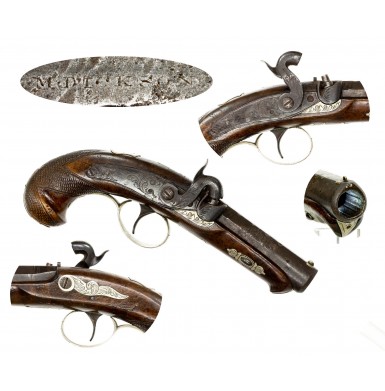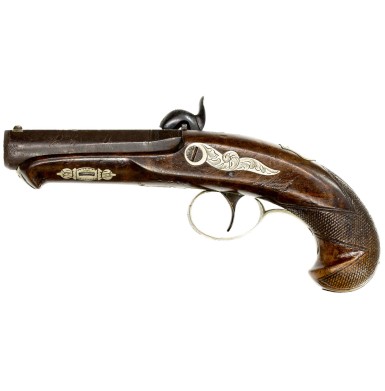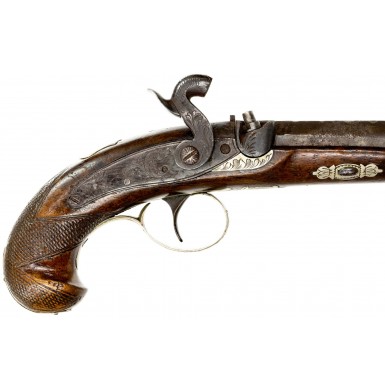Few handgun designs from the 19th century are more instantly recognizable than the pocket pistols of Henry Deringer. The success of his concealable, single-shot percussion pistols was obvious during the period, exemplified by the large number of contemporary imitators who produced similar handguns and sometimes even marked them with Deringer’s name. More indicative of the success of the design is the fact that Deringer’s name became a permanent part of the American lexicon, with the generic word “derringer” (note that this spelling has a double, rather than single “r”) coming to be a term for any easily concealable pocket pistol; a term that remains in general use to this day. The Deringer pistols came in a variety of sizes from “peanuts” with barrels shorter than 1”, to medium and large pistols, more akin to the English “overcoat pistols” of the period. However, all of the designs combined a curved wood grip with a back-action percussion lock and a relatively large bore, typically at least .44 caliber. While hardly target pistols, and certainly full of recoil, these compact powerhouses would certainly have been effective in an up close and personal confrontation.
One imitator of the Deringer design was Moses Dickson of Louisville, KY. Dickson was a gunsmith, gun maker and importer, and dealt in a full array of sporting items. From about 1848-1860 Dickson worked in Louisville, partnered with James J. Gilmore. Together, as Dickson & Gilmore, the pair operated a successful business located at No. 52 Third Street. Their March 18, 1853 advertisement in the Louisville Daily Courier read:
DICKSON & GILMORE, IMPORTERS AND DEALERS IN GUNS, PISTOLS AND FISHING TACKLE, No. 52 Third street near Main, Louisville, Ky., are now opening a large assortment of fine and plain Double-barrel Shot Guns, Game Bags, Shot Belts, Powder Flasks, Percussion Caps, Colt’s and Allen’s Revolvers, Gun Locks, Rifle Barrels, and Gun materials; also a large assortment of fine Fishing Tackle. This, with their large stock on hand, makes the most complete and largest stock that has ever been in this city, which we intend selling at still lower prices than heretofore. Rifles made to order; repairing done in the best manner.
The ad is accompanied by a picture of a pepperbox revolver. By 1858, the print advertisements had been modernized to depict a Colt Root revolver, but in all other ways provided essentially the same information as the earlier advertisement.
One of the products offered by the firm, although not specifically mentioned in the ad, were pocket pistols of the “derringer” pattern. To date, only a handful of these M DICKSON and marked pistols have been located, some of which are marked “Louisville, KY” and some are not. The extremely low survival rate of these guns suggests the production quantities were rather small, or that the guns saw hard use during the period and few survived. In either case, some estimates regarding extant examples of the Dickson pistols are as low as “fewer than ten known”, although this seems a somewhat unrealistic number. Louisville was a major transit hub during the mid-19th century, for goods and travelers heading west and returning to the east and the firm of Dickson & Gilmore was well situated to distribute their arms to both of the American coasts. As such, it would seem that a reasonable number of the guns were produced and sold, but for some reason they have not survived.
Offered here is an extremely rare M Dickson Marked Derringer Pistol. The gun has an unmarked back-action lock, but the barrel is clearly marked M DICKSON. Were the gun the work of Henry Deringer, it would probably be classified at the larger end of the “Small Pocket Sized” pistol class or are the bottom end of the “Medium Pocket Sized”, as it has a barrel that is just over 3” in length, measuring 3 1/16”. Like the smaller Deringer-made pistols, the gun is not fitted for a ramrod. The barrel is round, with a top flat, and angled upper side flats, very similar in silhouette to the pistols produced by Henry Deringer. While some other known examples have post-1813 Birmingham commercial proof marks on the bottom, this one does not. The firm was an importer of arms and gun parts, it is not strange that they would often choose to use a readily available commercial English barrel, and likely commercially made locks as well, simply stocking and assembling the two most difficult parts of any firearm to make, the lock and barrel, into a completed handgun. In this case, the lack of British proofs suggests that Dickson produced the barrel. Other than the maker mark on the barrel, the only other marks on the gun are the assembly number 5. This number is found under the barrel, under the breech plug, under the barrel wedge and on the hammer neck.
The bore of the pistol measures about .44” and is “rifled” with six grooves that are essentially straight. The pistol measures about 6 ¾” in overall length and uses mostly German silver mounts. The iron lock, hammer, breech, breech tang and bolster are all lightly engraved with simple feathery foliate scroll motifs. The German silver triggerguard is engraved in a similar fashion and the triggerguard terminates in an engraved pineapple style finial, reminiscent of the designs found on Deringer’s work during the late-1840s through the mid-1850s. The German silver sideplate is engraved with simple flowing foliate scrolls as well and the wedge escutcheon is engraved with geometric and floral patterns. The German silver buttcap and nosecap are both engraved with simple geometric boarders. The heads of the screws are also lightly engraved with simple radiating lines to create a rudimentary flower motif. A simple set of fixed sights are mounted on the pistol, a fixed notch rear and a dovetailed German silver blade front sight. A shield shaped German silver escutcheon is mounted as a thumbpiece on the upper rear of the grip.
This scarce Moses Dickson pistol remains in near VERY GOOD condition, showing moderate real-world wear. The pistol remains 100% complete, correct and original. The lock and hammer were probably originally color casehardened but now have a mostly even dark bluish-black patina. The barrel was probably originally browned and now has a rich, moderately oxidized brown patina. The barrel shows some scattered light pitting with a more moderate thumb-sized patch of pitting on the obverse angled flat, about half-way between the breech and muzzle. More moderate pitting is also present around the muzzle of the pistol. The barrel has a number of small impact mark on it, that partially obscure a couple of the letters in the M DICKSON marking however the marking remains completely legible. All of the decorative engraved patterns remain crisp and fully visible. The pistol is fully functional, with the lock operating crisply and correctly on all positions. There is a small chip in the face of the skirt at the hammer nose, a not uncommon problem with a thin skirt or with a pistol that was ever played with after the period of use. The bore is heavily oxidized with evenly distributed light to moderate pitting along its entire length. The German silver mountings have a moderately dull, slightly tarnished appearance. The barrel is secured to the stock by a single wedge and a screw through the breech plug tang. The one-piece walnut stock rates about VERY GOOD as well. The stock is solid and full-length with no breaks or repairs. The stock shows no signs of having been sanded and the Schnabel forend tip remains crisp and sharp. The bird’s head shaped butt is finely checkered and the checkering remains mostly sharp with some light to moderate wear and flattening from handling and use. As would be expected, the stock shows the usual scattered bumps, dings, handling marks and minor mars typically encountered on a 19th century pocket pistol.
Overall, this is a very nice, solid, and complete example of a very scarce Louisville, KY retailer marked percussion pocket pistol that was probably actually American and Kentucky made, rather than a retailer marked imported pistol. This rare M Dickson marked American derringer would be a fine addition to any Civil War era handgun collection, and as the product of a boarder state, this gun may well have gone off to war in 1861 as the pocket pistol for either a Yankee or Confederate soldier. It would also be equally at home in a collection of arms and memorabilia that center around the western expansion, the gold rush era or even riverboat gambling. This is one of those guns that were it able to talk, might well have some very interesting stories to tell, as it is from one of the most volatile and interesting periods of American history.
SOLD











